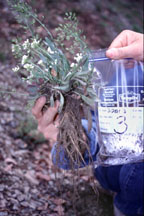|
West Lafayette, Indiana
August 13, 2001
Genes thought to allow plants to
accumulate large amounts of metal in their tissues have been
identified and cloned by a
Purdue University scientist.
The finding is expected to lead to new crop plants that can
clean up industrial contamination, new foods that fight disease
and reduced work for some farmers.
David E. Salt, associate professor of plant molecular physiology
and principal investigator on the project, says that this
discovery opens up new avenues for plant breeders.
|
"This is really one of the first
tools that we've got to manipulate this process of metal
hyperaccumulation," he says. "So what we're going to do now
is to start expressing these genes in nonaccumulating plants
to see if we can turn them into metal-accumulating plants."
The genes were identified from
the tiny wild mustard Thlaspi goesingense, a plant that
lives in the Austrian Alps, where it hyperaccumulates
nickel. The plant is similar to the nonmetal-accumulating
plant Arabidopsis thaliana, which is commonly used in
scientific research.
The research is published in the Tuesday (8/14) issue of the
Proceedings of the National Academy of Science.
Salt says more than 350 species of plants are known to
accumulate metal such as nickel, zinc, copper, cadmium,
selenium or manganese in high levels.
"The plant species that we're
interested in can accumulate 1 percent of their dry biomass
as nickel. In a normal plant you might expect to find 10 to
100 parts per million of nickel in their tissue, and these
plants can accumulate 10,000 parts
per million," he says. |
 |
Genes from this rare Austrian plant, called Thlaspi
goesingense, could allow
scientists to engineer plants that clean up polluted
industrial sites or to add essential micronutrients to food.
The plant, which is only found in the Austrian Alps, has the
rare ability to take up large amounts of nickel. The plant's
genes involved in metal accumulation have been identified
and cloned by David Salt, professor of plant molecular
physiology at Purdue University.
(Photo by David E. Salt.) |
"So they obviously have this
extraordinary capacity to accumulate metals, and they do this in
the wild without any interference from man. They just do this
for a living."
Hyperaccumulating plants store the metal in microscopic
structures in their cells called vacuoles. The vacuoles are
membrane-lined structures that protect the rest of the cell from
the toxic effects of the metal. Interestingly, the protective
membranes that surround the vacuoles closely resemble cell
membranes in the human liver that serve a similar function.
Scientists aren't completely sure why some rare plants try to
grab as much metal as they can, but studies indicate that they
do this to stop insects and other creatures from eating them.
Just as people hate to bite down on a piece of aluminum foil,
insects tend to avoid eating plants that taste like metal.
"You can imagine if you're a bug and you bite down on a plant
and it's got 10,000 parts per million of nickel in its leaf,
it's not going to taste too good," Salt says, laughing.
Scientists are interested in using metal hyperaccumulating
plants as a means to clean up contaminated brownfield sites.
Researchers believe that soil polluted with heavy metal or
radioactive materials could be cleaned up by using crop plants
that could absorb the material. This process is called
bioremediation, or more specifically when using plants,
phytoremediation.
"Imagine if you have a site contaminated with cadmium. Right now
your options are to put a fence around it and put a sign up
telling people to stay out, build a parking lot over it, or dig
up all of the soil and truck it to a landfill, which is very
expensive," Salt says. "The idea would be that you could take
plants that accumulate metal ‹ you could essentially farm the
metal out of the ground. Over five or 10 years, by growing crop
rotations there, you could remove the metal from the site. The
nice thing is that it's cheap, and you're left with a soil at
the end of it which could be used for other things."
Salt says the metal hyperaccumulating plants found in nature
would not be used for phytoremediation because they are all
small and slow growing. Instead, scientists could move the genes
Salt and his colleagues have identified into fast growing, large
plants, such as grasses.
Another benefit of Salt's work could be functional foods ‹ foods
that contain micronutrients missing from diets in certain areas.
Metals are essential nutrients in small doses, but some regions
of the world lack foods that contain sufficient levels of these
micronutrients, which causes severe health problems. Using the
genetic tools Salt and his colleagues have identified,
scientists could begin to bioengineer foods that contain these
essential micronutrients.
A third application of the research would be for improved crop
nutrition. "Instead of adding zinc to the soil because you live
in a zinc-deficient region, why not have the wheat plant itself
be more zinc-efficient so that you can reduce agricultural
inputs?" Salt asks.
Source: David Salt, (765) 496-2112;
salt@hort.purdue.edu
Writer: Steve Tally, (765) 494-9809;
tally@aes.purdue.edu
Related Web site:
Salt's professional Web site:
http://www.hort.purdue.edu/hort/people/faculty/salt.html
Related Story: Disease-fighting foods may be
derived from metal-loving plants
--
Jeanne Norberg, Director, Purdue News Service
(765) 494-2084;
jnorberg@purdue.edu
Pager: 423-8662; Home: 449-4986
Fax: (765) 494-0401
http://news.uns.purdue.edu
--
Beth Forbes, Ag News Coordinator
Ag Communications Service
(765) 494-2722
bforbes@aes.purdue.edu
Fax: (765) 496-1117
http://persephone.agcom.purdue.edu/AgCom/news/
Purdue University news release
N3719
|